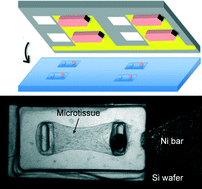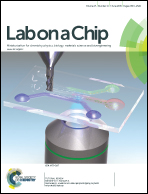A microfabricated magnetic actuation device for mechanical conditioning of arrays of 3D microtissues
Abstract
This paper describes an approach to actuate magnetically arrays of microtissue constructs for long-term mechanical conditioning and subsequent biomechanical measurements. Each construct consists of cell/matrix material self-assembled around a pair of flexible poly(dimethylsiloxane) (PDMS) pillars. The deflection of the pillars reports the tissues’ contractility. Magnetic stretching of individual microtissues via magnetic microspheres mounted on the cantilevers has been used to elucidate the tissues' elastic modulus and response to varying mechanical boundary conditions. This paper describes the fabrication of arrays of micromagnetic structures that can transduce an externally applied uniform magnetic field to actuate simultaneously multiple microtissues. These structures are fabricated on silicon-nitride coated Si wafers and contain electrodeposited Ni bars. Through-etched holes provide optical and culture media access when the devices are mounted on the PDMS microtissue scaffold devices. Both static and AC forces (up to 20 μN on each microtissue) at physiological frequencies are readily generated in external fields of 40 mT. Operation of the magnetic arrays was demonstrated via measurements of elastic modulus and dynamic stiffening in response to AC actuation of fibroblast populated collagen microtissues.


 Please wait while we load your content...
Please wait while we load your content...